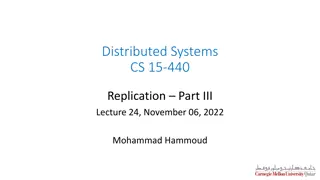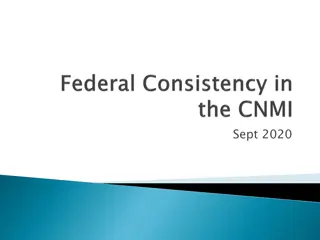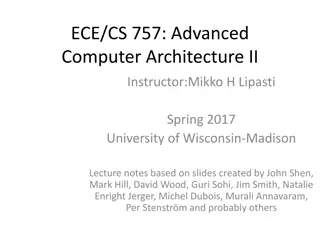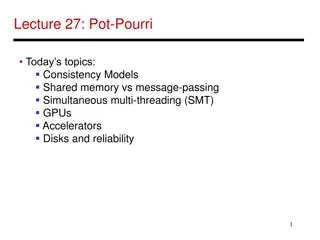Managing File System Consistency in Operating Systems
File systems in operating systems face challenges with crash consistency, especially during write operations. Issues arise when modified data in cache is lost due to system crashes or when data structure invariants are violated. Solutions like write-through and write-back caches help mitigate these
6 views • 14 slides
Consistency Protocols in Distributed Systems
Today's lecture covers consistency protocols in distributed systems, focusing on primary-based protocols and replicated-write protocols. These protocols play a crucial role in ensuring consistency across multiple replicas. One example discussed is the Remote-Write Protocol, which enforces strict con
2 views • 35 slides
Federal Consistency in Coastal Zone Management
This presentation serves as an introduction to Federal Consistency in the context of Coastal Zone Management, emphasizing the importance of compliance with enforceable policies outlined in the Coastal Zone Management Act. It highlights the role of the Division of Coastal Resources Management (DCRM)
3 views • 13 slides
Replication and Consistency in Computer Systems
Explore the concepts of replication and consistency in computer systems, discussing the benefits and challenges of using replicas for reliability, performance, and scalability. Learn about object replication problems and solutions, and the importance of maintaining consistency in shared data access.
1 views • 26 slides
Properties of Database Transactions
Database transactions play a crucial role in ensuring data integrity and consistency within a database system. This content explores the fundamental properties of transactions, such as atomicity, durability, consistency, and isolation. It delves into the requirements and implications of each propert
2 views • 44 slides
Causal Consistency in Distributed Systems
This content covers the concept of causal consistency in computing systems, exploring consistency models such as Causal Linearizability and Eventual Sequential. It explains the importance of logical clocks like Lamport and vector clocks, and how they ensure order in distributed systems. The concept
0 views • 35 slides
Scalable Causal Consistency for Wide-Area Storage with COPS
This paper delves into the importance of scalable causal consistency for wide-area storage with the COPS system. It explores desired properties such as availability, low latency, partition tolerance, and scalability within data centers. The document discusses the challenges of achieving consistency
0 views • 41 slides
Memory Consistency Models and Sequential Consistency in Computer Architecture
Memory consistency models play a crucial role in ensuring proper synchronization and ordering of memory references in computer systems. Sequential consistency, introduced by Lamport in 1979, treats processors as interleaved processes on a shared CPU and requires all references to fit into a global o
1 views • 64 slides
Discussions on Programmers' Needs, Memory Models, and Consistency in Software Development
Today's discussions covered various topics including what programmers require, the debate on defining memory models for achieving Sequential Consistency (SC), considerations for data-race-free programs, and the performance trade-offs of weaker memory architectures. Insights into partial and relaxed
3 views • 22 slides
Consistency at Facebook: A Study on Existential Consistency
This study explores the measurement and comprehension of consistency at Facebook, focusing on existential consistency. Key topics covered include consistency performance, fundamental tension between consistency and performance, anomalies in Facebook systems, and strategies for quantifying and preven
0 views • 30 slides
Ensuring Consistency and Addressing Data Issues in Climate Change Observations
This content delves into the efforts to maintain consistency among different essential climate variables and related datasets. It discusses interactions with the CCI Data Portal and Toolbox projects, as well as challenges such as data gaps, uncertainty descriptions, and issues with data formats. Str
0 views • 9 slides
Memory Consistency Models and Communication Paradigms in Computer Systems
Memory consistency models define the ordering of writes and reads in computer systems. Coherence ensures write propagation and serialization, while consistency models guide programmers in writing correct programs. Shared-memory and message-passing are two communication paradigms with different appro
1 views • 31 slides
Ensuring Integrity and Consistency in Remote Storage Systems
Venus project aims to address trust issues in cloud storage by guaranteeing integrity and consistency to users even in the presence of faults. It explores strong consistency requirements, challenges in achieving it, and proposes solutions like fork linearizability to handle faulty servers effectivel
0 views • 18 slides
The CAP Theorem and Database Consistency
Exploring the CAP Theorem introduced by Eric Brewer, the concept of Basic ACID semantics in databases, the importance of consistency, and examples elucidating atomic writes and sequential consistency in multi-process execution.
0 views • 22 slides
Principles of Data Validation and Quality Evaluation According to ISO Standards
Explore the key principles of data validation and quality evaluation as outlined by ISO standards. The content covers the importance of logical consistency, format consistency, and the ordering of data quality evaluation process. It delves into the assessment of data completeness, accuracy, and suit
0 views • 26 slides
Strong Consistency and CAP Theorem in Distributed Systems
Strong consistency and the CAP theorem play a crucial role in the design and implementation of distributed systems. This content explores different consistency models such as 2PC, consensus, eventual consistency, Paxos, and Raft, highlighting the importance of maintaining ordering and fault-toleranc
0 views • 29 slides
Strong Consistency and CAP Theorem
Explore the concepts of strong consistency, CAP theorem, and various consistency models such as 2PC, consensus, eventual consistency, Paxos, Raft, and Dynamo. Learn about fault-tolerance, durability, and the importance of correct consistency models in distributed systems. Understand how Paxos and Ra
2 views • 29 slides
CRG.BoG Main Topics: Observations & Consistency in Climate Studies
This document discusses observations, data continuity, validation methods, and consistency in climate studies. It touches on using available instruments, addressing data gap issues, lack of ground-based observations, and ensuring consistency between different Essential Climate Variables (ECVs). Vari
0 views • 8 slides
Shared Memory Coherence, Synchronization, and Consistency in Embedded Computer Architecture
This content delves into the complexities of shared memory architecture in embedded computer systems, addressing key issues such as coherence, synchronization, and memory consistency. It explains how cache coherence ensures the most recent data is accessed by all processors, and discusses methods li
1 views • 47 slides
Strong Consistency & CAP Theorem in Computing Systems
Explore the concepts of strong consistency, CAP theorem, network partitions, linearizability, and how systems handle partitions. Delve into the trade-offs between consistency, availability, and partition-tolerance as outlined by the CAP theorem.
0 views • 42 slides
Developing Dependability and Consistency in Personal Skills: A Comprehensive Guide
Understanding dependability and consistency as essential traits in personal skills is crucial for success in the workplace. This guide explores the meanings of dependability and consistency, their relationship, why they are important, and how to demonstrate them effectively. Students will discover s
0 views • 10 slides
Causal Consistency in Computing Systems
Explore the concept of Causal Consistency in Computing Systems, covering topics such as consistency hierarchy, Causal+ Consistency, relationships in causal consistency, practical examples, and its implementation within replication systems. Learn how it ensures partial ordering of operations and conv
0 views • 31 slides
Scalable Causal Consistency for Wide-Area Storage with COPS
This paper discusses the implementation of scalable causal consistency in wide-area storage systems using COPS. It delves into the key-value abstraction, wide-area storage capabilities, desired properties such as ALPS, scalability improvements, and the importance of consistency in operations. Variou
0 views • 42 slides
Enhancing Storage Consistency in Persistent Memory Systems
Persistent memory systems face challenges with strict write ordering requirements affecting performance. This study introduces Loose-Ordering Consistency to minimize overhead while ensuring storage consistency by leveraging hardware support and innovative commit protocols. Results show a significant
0 views • 26 slides
Spanner Database Overview
Spanner is a globally distributed database system that offers configurable control, consistent commit timestamps, external consistency, and TrueTime API for handling distributed data. It uses a transaction model with two-phase locking and lock-free reads, providing globally sortable timestamps. The
0 views • 19 slides
Reliability Measures in Research Supervised by Dr. Mohammed Mahdi Sharifi
Reliability is crucial for assessing the consistency of metrics in research. Various methods such as inter-rater reliability, test-retest reliability, parallel forms reliability, and internal consistency reliability help ensure the dependability of research findings. By examining factors like judgme
0 views • 9 slides
Federal Consistency Overview in CNMI
Coastal Zone Management Act (CZMA) empowers the Commonwealth of the Northern Mariana Islands (CNMI) in federal decision-making. The Division of Coastal Resources Management (DCRM) oversees the CNMI's Coastal Management Program approved by NOAA, aiming for sustainable development and conservation. Va
0 views • 10 slides
Eventual Consistency Transactions Overview
Learn about eventual consistency transactions, CAP theorem compromises, and the need for different consistency models in distributed systems and web programming.
0 views • 57 slides
Java Memory Model: Execution, Consistency, and Optimization
The Java memory model governs how Java code is executed, emphasizing sequential consistency, main memory interactions, and processor caching. Learn about the complexities of execution, optimizations, and eventual consistency in multi-threaded applications.
0 views • 35 slides
Scalable Causal Consistency Using Dependency Matrices
This study explores Orbe, a system that achieves scalable causal consistency through dependency matrices and physical clocks. It discusses key-value data store APIs, partitioning strategies, data center structuring, geo-replication, consistency models, and the implementation of causal consistency in
1 views • 37 slides
Understanding Database Principles: ACID, CAP, and BASE
Explore the fundamental principles governing classical relational databases such as ACID rules, CAP theorem, and BASE characteristics. Learn about transaction integrity, consistency, isolation, and durability, as well as the trade-offs between consistency, availability, and partition tolerance in di
0 views • 9 slides
Understanding the CAP Theorem and Consistency in Distributed Systems
Explore the concepts of the CAP Theorem, consistency, ACID semantics, atomicity, and sequential consistency in distributed systems, with insights from Prof. Smruti R. Sarangi from IIT Delhi.
0 views • 22 slides
Ensuring Consistency in UNFCCC and Kyoto Protocol Reporting and Review Guidelines
Explore the importance of consistency in UNFCCC and Kyoto Protocol reporting guidelines, focusing on issues identified in recent review cycles and potential conclusions. The background emphasizes the responsibility of lead reviewers, supported by the secretariat and ERTs, to maintain consistency acr
0 views • 24 slides
Understanding Causal Consistency in Computing Systems
Explore the concept of Causal Consistency in computing systems, which partially orders all operations based on causality, ensuring replicas converge to the same state. Learn about its significance, examples, and how it differs from other consistency models.
0 views • 31 slides
Understanding Causal Consistency in Distributed Systems
Explore the concept of Causal Consistency in Distributed Systems through lectures on consistency models, logical clocks, and practical applications. Learn how writes are ordered, concurrent operations are handled, and the role of physical time.
0 views • 39 slides
Understanding Data Consistency in Distributed Systems
Learn about strong vs. weak consistency, CAP theorem, linearizability, broken protocols, non-linearizable history, and fixed protocols in distributed systems to grasp the importance of data consistency for system reliability and performance.
0 views • 17 slides
Understanding Causal Consistency in Distributed Systems
Explore the concept of causal consistency in distributed systems, focusing on the order of potentially causally related writes and the handling of concurrent operations. Learn about logical clocks, consistency models, distributed bulletin board applications, and more. Delve into quizzes on the valid
0 views • 39 slides
Understanding Client-Centric Consistency Models in Distributed Systems
Explore the concept of client-centric consistency models in distributed systems, focusing on providing views tailored to specific client needs. Learn about eventual consistency, basic architecture, and ensuring consistency for mobile users in this informative content.
0 views • 21 slides
Heuristic Evaluation and Interface Consistency in HCI Learning
Explore the principles of heuristic evaluation and interface consistency in HCI, focusing on components like consistency, error recovery, and error prevention. Learn the importance of predictability and different types of consistency within interfaces. Discover how to help users recognize, diagnose,
0 views • 33 slides
Understanding Arc Consistency in Constraint Satisfaction Problems
Dive into the concept of arc consistency in constraint satisfaction problems. Learn how propagation ensures consistency in all arcs within the CSP, and the importance of managing queues for effective problem-solving. Explore examples and illustrations to grasp the concept better.
0 views • 17 slides







































